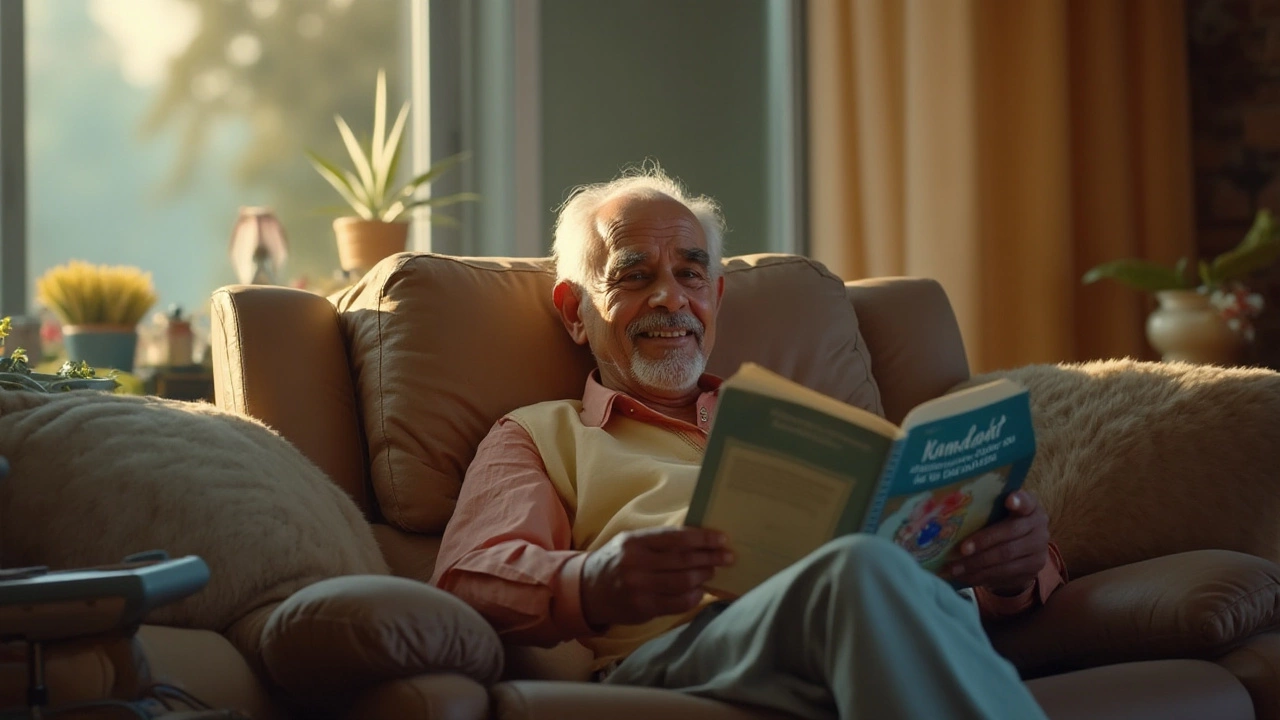
- Dec, 24 2024
- 0
Open-heart surgery marks a significant milestone in one’s medical journey, often with profound implications on daily living. As you embark on the road to recovery, the question of when you can live alone emerges as a key concern. Balancing the desire for independence with the requirements for safety and health is crucial.
This article delves into various aspects of post-operative recovery to help you gauge when living alone might be feasible. It covers the timelines, physical readiness, emotional factors, and practical considerations essential for a smooth transition. With clear guidance and meaningful insights, you'll be better equipped to navigate this important phase of your recovery journey.
- Understanding Recovery Timelines
- Assessing Physical Readiness
- Emotional Preparedness and Support
- Practical Tips for Independent Living
Understanding Recovery Timelines
The journey to recovery after an open-heart surgery is unique to each person, influenced by a variety of factors including age, general health, and the specific procedure undertaken. On average, patients can expect a recovery period of 6 to 12 weeks before they regain a level of functionality close to their pre-surgery state. However, this timeline is not set in stone and requires personalized attention. Typically, the first few weeks demand the most care, where even minor activities can seem overwhelming.
In the first week post-surgery, patients often remain in the hospital where medical staff closely monitor their condition, helping to stabilize heart function and pain management. Once discharged, the initial weeks at home focus on basic recovery. This period is crucial for healing, where rest is paired with gradual mobility exercises. It is during this time that the groundwork for long-term recovery is laid, emphasizing the importance of these early stages. A patient might experience fatigue, discomfort, and rely heavily on support for day-to-day activities.
As weeks progress, the transition becomes evident, marking a shift towards increased physical activity and independence. Walking, light household tasks, and eventually, resuming work (perhaps on a part-time basis) become achievable milestones. Patients are often encouraged to engage in cardiac rehabilitation programs which are widely recognized for improving cardiovascular health post-surgery. These programs offer structured exercise routines and vital education on lifestyle modifications.
Dr. Linda Schwartz, a renowned cardiologist, notes,
"The recovery process is not just about physical healing; it's about embracing a new lifestyle that prioritizes heart health and longevity. Patients should approach this journey with patience and a positive mindset."This holistic view of recovery underscores the integration of physical, emotional, and lifestyle adjustments essential for sustainable health.
Moreover, external support systems play a critical role. Family, friends, and caregivers provide a framework within which recovery flourishes. They assist not only with physical tasks but also offer emotional support crucial for overcoming the psychological challenges such as anxiety and depression that can arise post-surgery. The timeline to live alone post-surgery, therefore, extends beyond just physical ability, factoring in emotional readiness and daily activity management.
A deep dive into the statistics related to open-heart surgeries reveals that compliance with post-operative guidelines significantly boosts recovery outcomes. For instance, adherence to prescribed medication, exercise, and dietary adjustments correlate strongly with positive health indicators. As patients progress through the recovery timeline, they are encouraged to frequently engage with their healthcare providers, nurturing a feedback loop that adapts as recovery unfolds.

Assessing Physical Readiness
When considering independent living post open-heart surgery, assessing your physical readiness is a fundamental step. This is often a multifaceted evaluation, influenced by individual health circumstances and the specific nature of the surgery performed. A standard recovery plan typically begins in the hospital, where patients spend several days under close monitoring. While hospital staff provides excellent guidance during this initial stage, the real test begins once you return home. It’s crucial to understand that your body will demand time to heal, and patience is your strongest ally. Remember, everyone heals at their own pace, and comparisons to others’ experiences can lead to unnecessary stress.
Your healthcare team plays a pivotal role in helping you navigate this important transition. They will assess your progress through follow-up appointments, checking on the healing of your incision, your heart rate, and your overall ability to perform daily activities. Regular consultations with your cardiologist are likely to offer insights into your recovery timeline. Generally, doctors suggest that patients wait several weeks to a few months before attempting to live alone, depending on how well they are recovering and their individual circumstances. During this period, your endurance and strength will gradually improve. Often, cardiac rehabilitation programs are recommended. These programs are designed to help you build endurance and confidence in a structured and supportive environment.
Your ability to manage routine activities safely and comfortably is a key indicator of your readiness. This includes personal hygiene, meal preparation, and taking medication on time. Some may require minimal assistance with these activities, which is perfectly normal. It’s also vital to be cautious while lifting objects or performing tasks that strain the chest area to avoid any setbacks. As mobility increases, some doctors even recommend gentle exercises like short walks to aid recovery.
A study indicated that approximately 80% of patients who attended cardiac rehabilitation felt more equipped to manage daily life independently after completing the program.
“Cardiac rehabilitation can substantially influence a heart surgery patient’s return to normal life,” says Dr. John Smith, a noted cardiologist. “The program is tailored to individual needs, aiming at recovery through holistic support and guidance.”This reinforces the idea that though the path might be challenging, there are structured ways to ease you into independent living.
Lastly, be mindful of the signs your body may be telling you. Fatigue, discomfort, or increased heart rate can signal the need to slow down. Recording your physical activity can be helpful for tracking progress and recognizing when adjustments are necessary. A journal or a simple phone app can serve this purpose well. Including data like your daily step count or heart rate can provide useful insights into your recovery process. In open-heart surgery recovery, listening to your body and maintaining open communication with healthcare providers ensures a smooth and steady journey towards living independently.

Emotional Preparedness and Support
Emotional readiness is a crucial aspect often overlooked in the wake of open-heart surgery recovery. Adjusting to life after such an intense medical event requires not just physical healing but emotional resilience as well. Many patients find themselves grappling with feelings of vulnerability, anxiety, and even depression. It's essential to acknowledge these emotions as part of the process and to seek out avenues for support. Building a support system can help mitigate these feelings, providing much-needed comfort and encouragement during this critical time.
Why focus on the emotional side, you may ask? Returning to independent living post-surgery involves more than just physical capabilities. Confidence and peace of mind are equally vital. The heart and mind are intricately connected, and as your body recovers, so too can your spirit flourish with proper care. Talking with professionals such as therapists can be immensely beneficial. Therapy offers a safe space to process your emotions, develop coping mechanisms, and gradually regain your confidence.
Engaging with support groups is another valuable way to nurture emotional wellness. These groups provide a community of individuals who have undergone similar experiences, offering empathy and shared understanding. Reaching out to loved ones, family, and friends, to express your worries and aspirations plays a massive role in your recovery journey. They can offer practical help and companionship. According to a study published in the Journal of Cardiac Surgery, patients who had robust social support were more likely to experience better recovery outcomes.
"It is not the strongest of the species that survive, nor the most intelligent, but the one most responsive to change." - Charles Darwin. This quote serves as a poignant reminder that adaptability and resilience are key as you transition to living alone.
Don't underestimate the power of positive thinking. Staying optimistic can significantly enhance your recovery experience. Integrating practices such as meditation, mindfulness, or gentle yoga helps reduce stress and promotes emotional well-being. Many find comfort in creative outlets like writing or art, which allow for expression and can serve as a therapeutic release. If motivation dips, visualize the freedom and independence you wish to reclaim; these are powerful incentives to keep progressing.
Finally, remember it's okay to set small, achievable goals. Not every day will be the same, and that's perfectly normal. Celebrate the triumphs and learn from setbacks without harsh self-criticism. Surrounding yourself with positivity, relying on a strong support network, and embracing your journey can significantly boost your emotional and mental readiness to live independently after heart surgery.

Practical Tips for Independent Living
Embracing independent living following open-heart surgery recovery requires both a strategic approach and an acute sensitivity to your body’s signals. Preparing your home environment for safety and convenience becomes imperative during these early days of transition. It is beneficial to keep frequently used items, like kitchen utensils or medications, within easy reach to prevent unnecessary strain. Rearrange furniture to ensure pathways are clear of obstacles, preventing any tripping hazards. Such adjustments facilitate ease of movement and reduce the risk of falls, a common concern during this recovery stage. Additionally, installing grab bars in bathrooms near toilets and inside showers can offer extra support, providing both safety and confidence as you navigate these essential spaces.
Emotional resilience plays a critical role in independent living post-surgery. Maintaining an active line of communication with a support system comprised of friends, family, or professional caregivers can alleviate loneliness and provide motivation during strenuous times. Embrace technology by utilizing video calls, which allow face-to-face interactions and emotional support whenever necessary. Consider setting up a checklist of daily mental health activities, such as meditation, guided breathing exercises, or even engaging in a creative hobby that offers relaxation and reduces stress. A Harvard Medical School study emphasizes, "A positive outlook speeds recovery and enhances the quality of life in cardiac patients." Keeping this perspective aids not just physical recuperation, but mental well-being too.
A critical component underlined in returning to independent living post-surgery is adhering to a balanced routine that encompasses both rest and light physical activity. Many doctors recommend starting with short, frequent walks, increasing distance gradually as stamina builds. This not only aids in circulation but also strengthens muscle recovery. Create a daily schedule that integrates these walks along with regular medication reminders to streamline the healing process. Consistency is key, thereby allowing the body to mend efficiently while reducing the risk of unnecessary exertion. Consulting a physical therapist to devise a personalized exercise regimen can offer additional benefits, ensuring that the activities align with your specific health needs.
Home-cooked meals emerge as an essential part of regaining strength after surgery, but managing kitchen tasks might initially feel daunting. To navigate these early hurdles, consider batch-cooking meals in advance or utilizing services that deliver nutritious meals tailored to cardiac health. A diet rich in fruits, vegetables, lean proteins, and whole grains provides vital nutrients, aids recovery, and maintains heart health. Mindful eating not only supports physical health but can also become a soothing daily ritual, reinforcing self-reliance and care.
Leveraging technology plays a pivotal role in easing the shift towards living alone. Smart home devices like voice-activated assistants can set reminders for medications, call for help in emergencies, and manage alarms to maintain a structured day without requiring physical strain. Such technology fosters a sense of security and independence, especially when mobility is temporarily compromised. Importantly, many cardiac rehabilitation programs offer virtual support sessions, further bridging the gap between medical guidance and daily living, ensuring a seamless transition back to a self-sustained lifestyle.
Nikhil Verma
I'm a dedicated physician with a passion for exploring the intricacies of medicine, focusing on the unique healthcare challenges in India. I spend much of my spare time writing articles aimed at improving public understanding of health issues. Balancing my clinical practice and writing allows me to reach a wider audience, sharing insights and fostering a deeper appreciation for medical advancements. I derive immense satisfaction from both treating patients and engaging with readers through my writing.